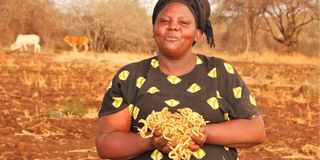Breaking News: Old Kijabe dam tragedy: Death toll rises to 45
Acacia, the tree that keeps livestock healthy during dryspells

Francisca Mutuku collects acacia pods at Ndovoini Village in Makueni County on September 6, 2023. She sells them to pastoralists who use them as livestock feed. PHOTO: PIUS MAUNDU
Two giant racks greet visitors entering Franscisca Mutuku's homestead in Ndovoini Village, Makueni County. Until last year, the peasant farmer used the racks to store maize stovers, which she would use to feed her livestock at the height of the dry season.
But with the region recording poor maize yields in the last season, the structures have found new use — holding sack loads of acacia pods. These pods are the latest craze in the sleepy region overlooking Chyullu Hills.
“Trading in acacia pods started last year at the height of the prolonged drought. We realised that waa is a source of income after pastoralists from the neighbouring Kajiado County came looking for it,” Ms Mutuku told Climate Action, referring to the pods by their local name.
A walk around her farm shows that it stands out in the neighbourhood. Unlike many of her neighbours who have cut down acacia trees to make charcoal, the mother of five has jealously protected those that grow on her 10-acre farm, where she also grows maize and pigeon peas. Ms Mutuku became the talk of town after collecting and selling 40 bags of acacia pods at the height of the dry spell last year.
She pocketed Sh40,000, which she used to buy foodstuffs when her neighbours stared at starvation. She also used part of the money to pay school fees for two of her children, who are in secondary school.
“It has since become unthinkable to cut down an acacia tree in this area. My target this year is 100 bags,” she said while overseeing a team collecting acacia pods at the farm.
Known scientifically as Acacia Tortillas, the umbrella thorn acacia is a major source of livestock feed.
“Acacia pods and leaves are rich in protein, fibre and minerals,” said Bernard Kigwa, a senior scientist involved in studying and promoting acacia at the Kenya Forest Research Institute (Kefri). This confirms observations by farmers who hail the pods as a superior feed.
“We are not worried about depletion of pasture for our livestock during the dry spell since we stock enough acacia pods. Young goats fed on the pods grow very fast,” said Benson Maingi, a Nairobi-based accountant who keeps livestock as a side hustle in Yimbuvu Village. Ms Mutuku is among the farmers who supply him with the pods.
The acacia pods collection craze has also taken hold in the neighbouring Kitui County, where pastoralists from the neighbouring Garissa, Mandera, Tana River and Wajir traverse the region looking for the pods.
“Acacia pods were a lifeline for herders in the larger Mwingi region, Kitui when the country experienced one of the worst droughts last year. We did not lose livestock because farmers had no problem with animal feed,” said Francis Koma, head of the National Drought Management Authority in Kitui County.
The acacia pods business starts in August and September when the pods dry. The farmers use hooked sticks to methodically shake the trees before picking the pods. A single tree can yield up to 15 bags of pods.
The lucrative business has spurred the emergence of dozens of middlemen who buy the commodity from farmers and aggregate in giant warehouses. The traders offer between Sh800 and Sh1,000 per bag of dry pods and then sell at higher prices. The guaranteed survival rate and the fact that acacia fixes nitrogen into the soil explain aggressive campaigns by conservationists, who promote the tree as one of the most suitable species for restoring degraded landscapes in semi-arid regions.
Immaculate Mutule, who runs an indigenous tree nursery in Nthongoni area near Mtito Andei, says the popularity of acacia seedlings has increased tremendously recently.
“Although propagating acacia tortillas seedlings is challenging as it starts with boiling the seeds to break their dormancy, the seedlings are the cheapest in the market. We sell a seedling at Sh30. This is one of the reasons the acacia seedlings are fast-moving. The other reason is that the survival of acacia tortillas in semi-arid regions is guaranteed. They tolerate drought,” Ms Mutule told Climate Action.
“Trading in acacia pods is a big incentive to conservation,” said Joshua Kioko, an environmental scientist. Similarly, scientists at Kefri are betting big on the emerging environmental conservation stewards to boost conservation as the government targets to grow 15 billion new trees by 2030. According to Albert Luvanda, the head of Kefri’s arid lands research station located in Kitui town, the forest research agency has embarked on studies to enhance the value of acacia trees as animal feed and wood fuel.
Kefri has established acacia field trials at Tiva in Kitui County and Kibwezi in Makueni County. Among the technologies Kefri has rolled out in promoting the propagation of acacia is the multi-stage adjustable rolled container, an environmentally friendly potting material. “The new potting method uses coco peat medium rather than soil. Telling from the preliminary results available, acacia seedlings grown in this adjustable material mature faster when compared to those grown in the traditional polythene bags,” said Mr Luvanda.
Authorities and scientists are upbeat about the acacia pods craze sweeping across arid and semi-arid regions. The ongoing campaign to promote the hardy tree is set to address land degradation by controlling soil erosion while contributing significantly to making the world cooler.
“With enhanced acacia stands mushrooming in degraded regions, we are looking at significant carbon dioxide sequestration and the emergence of nature-based enterprises such as beekeeping. The resulting income will enhance communities’ adaptation to the adverse effects of climate change,” Mr Kioko said.



